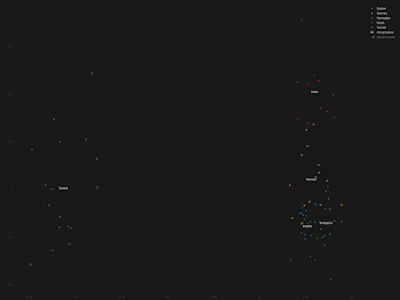Chimp Yamnaya_Samara Swedish_modern Polish_modern -0.000311 -1.574 Chimp Yamnaya_Samara Ollsjo_Bronze_Age Polish_modern -0.000044 -0.152 Chimp Yamnaya_Samara Sealand_Iron_Age Polish_modern -0.000072 -0.293 Chimp Yamnaya_Samara Sealand_Viking_Age Polish_modern 0.000078 0.525 Chimp Yamnaya_Samara Gotland_Viking_Age Polish_modern -0.000141 -1.322 Chimp Barcin_N Swedish_modern Polish_modern -0.000318 -1.662 Chimp Barcin_N Ollsjo_Bronze_Age Polish_modern 0.000216 0.798 Chimp Barcin_N Sealand_Iron_Age Polish_modern -0.000023 -0.104 Chimp Barcin_N Sealand_Viking_Age Polish_modern -0.000186 -1.310 Chimp Barcin_N Gotland_Viking_Age Polish_modern 0.000083 0.788 Chimp Karelia_HG Swedish_modern Polish_modern -0.000134 -0.540 Chimp Karelia_HG Ollsjo_Bronze_Age Polish_modern 0.000056 0.162 Chimp Karelia_HG Sealand_Iron_Age Polish_modern 0.000047 0.153 Chimp Karelia_HG Sealand_Viking_Age Polish_modern 0.000424 2.241 Chimp Karelia_HG Gotland_Viking_Age Polish_modern 0.000134 0.959Simply put, if Poles have ~25% ancestry from a Turkish-related source, then so do Swedes, Norwegians and basically all other Northern Europeans going back hundreds and even thousands of years. This is obviously not the case, and it's also not what Hellenthal et al. claimed anyway. A year later, a team of scientists that again included Garrett Hellenthal, George B. J. Busby, James F. Wilson, Cristian Capelli and Simon Myers, published another, similar paper in Current Biology. And guess what? This paper also claimed that present-day Poles had Turkish-related ancestry, but this time dating to a somewhat later period. See Busby et al. 2015 Figure 4.C here. I've got most of the samples from that paper, so I can analyze them myself, and I think I know what the problem is. Basically, the Turks are mixed. So what appears to have happened is that Busby et al. got things backwards. Below are three plots from a Principal Component Analysis (PCA) largely based on data from Busby et al., featuring samples from England, Germany, Norway, Poland and Turkey. The first plot is based on dimensions 1 and 2, the second plot on dimensions 1 and 3, and the third plot on dimensions 1 and 4. The relevant data file is available here. Note that the Europeans are more or less symmetrically related to the Turks, which means none of these European populations has significantly more Turkish-related ancestry than the others. Indeed, it's the Turks who show more variation in the first (horizontal) dimension, suggesting that they might have variable levels of European ancestry. I chose the aforementioned papers to make my point here because they made quite an impression on me. In other words, they really pissed me off. For the sake of completeness, I'm now going to try and get in touch with the authors and ask them how on earth they managed to make these Poles Turkish-related, and also why they never corrected their mistake. See also... Don't believe everything you read in peer reviewed papers
Focusing on Polish and European population genetics and modern physical anthropology.
Tuesday, January 11, 2022
Population genetics is a state of mind
Years of blogging about population genetics has seriously eroded my faith in the peer review process.
During the past decade I've witnessed an inordinate amount of crap published in basically all of the major science journals. Often the work is misguided in some way, sometimes even quite strange, and occasionally outright wrong.
Back in 2014, a team of scientists from the UK published a paper in Science emphatically titled A Genetic Atlas of Human
Admixture History. These people were Garrett Hellenthal, George B. J. Busby, Gavin Band, James F. Wilson, Cristian Capelli, Daniel Falush, and Simon Myers. See here.
The thing that really sticks out for me in this paper is Figure 3, which shows the present-day Polish population as largely a mixture between Northern European- and Turkish-related ancestries. Incredibly, the Turkish-related ratio appears to be about 25% and dated to 438 CE.
This is not just inexplicable, but utterly wrong. It's a result that is impossible to reproduce with any standard population genetics methods.
In fact, in terms of deep ancient ancestry, present-day Poles are very similar to present-day Scandinavians, and even to Viking Age, Iron Age and Bronze Age Scandinavians. This is easy to demonstrate, for instance, with f4-statistics, in part based on samples from the Hellenthal et al. paper.


